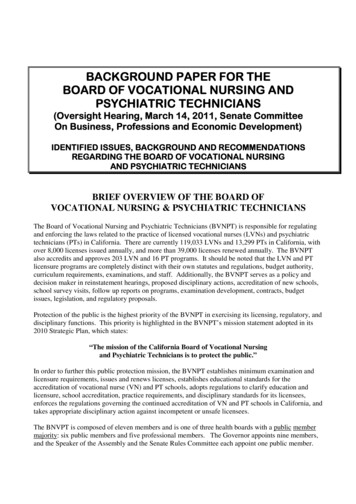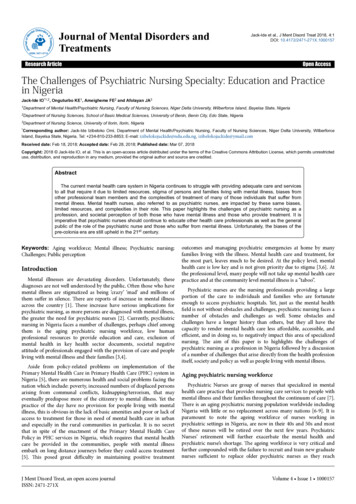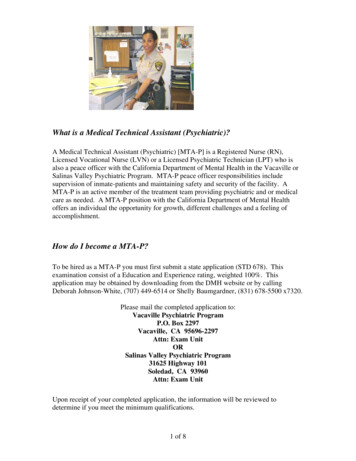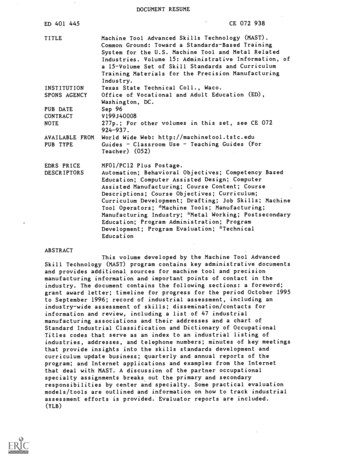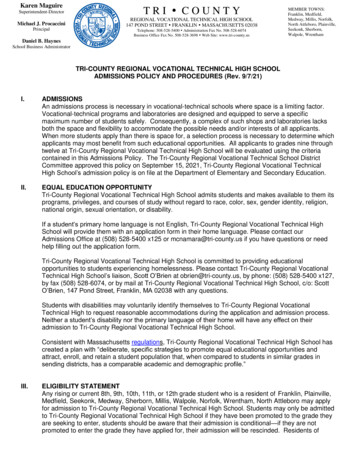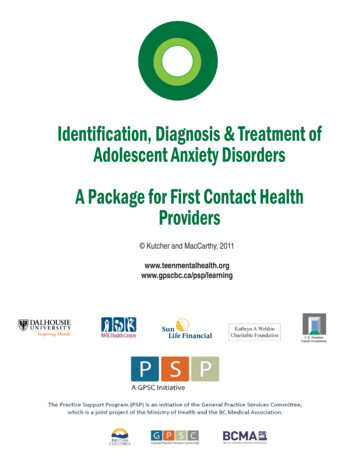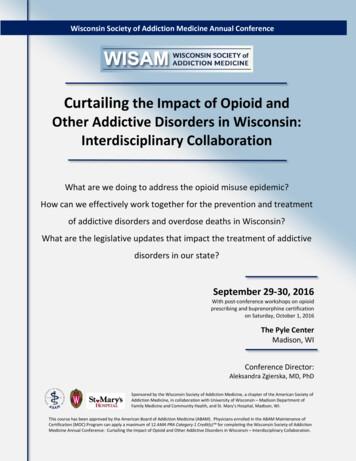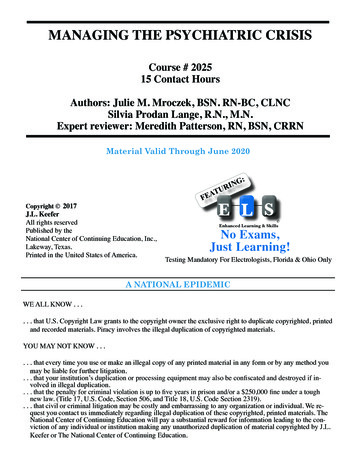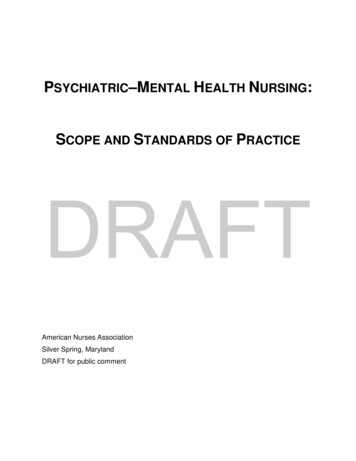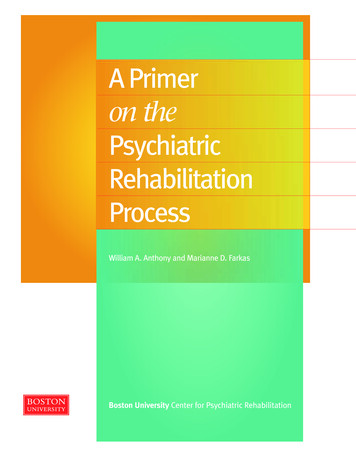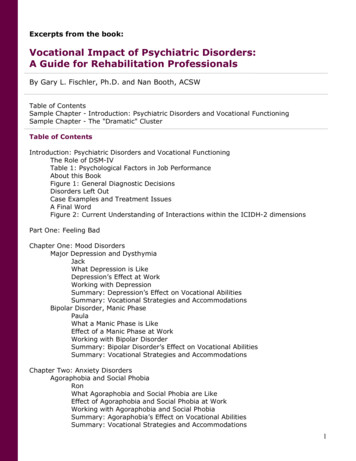
Transcription
Excerpts from the book:Vocational Impact of Psychiatric Disorders:A Guide for Rehabilitation ProfessionalsBy Gary L. Fischler, Ph.D. and Nan Booth, ACSWTable of ContentsSample Chapter - Introduction: Psychiatric Disorders and Vocational FunctioningSample Chapter - The "Dramatic" ClusterTable of ContentsIntroduction: Psychiatric Disorders and Vocational FunctioningThe Role of DSM-IVTable 1: Psychological Factors in Job PerformanceAbout this BookFigure 1: General Diagnostic DecisionsDisorders Left OutCase Examples and Treatment IssuesA Final WordFigure 2: Current Understanding of Interactions within the ICIDH-2 dimensionsPart One: Feeling BadChapter One: Mood DisordersMajor Depression and DysthymiaJackWhat Depression is LikeDepression’s Effect at WorkWorking with DepressionSummary: Depression’s Effect on Vocational AbilitiesSummary: Vocational Strategies and AccommodationsBipolar Disorder, Manic PhasePaulaWhat a Manic Phase is LikeEffect of a Manic Phase at WorkWorking with Bipolar DisorderSummary: Bipolar Disorder’s Effect on Vocational AbilitiesSummary: Vocational Strategies and AccommodationsChapter Two: Anxiety DisordersAgoraphobia and Social PhobiaRonWhat Agoraphobia and Social Phobia are LikeEffect of Agoraphobia and Social Phobia at WorkWorking with Agoraphobia and Social PhobiaSummary: Agoraphobia’s Effect on Vocational AbilitiesSummary: Vocational Strategies and Accommodations1
Post-Traumatic Stress DisorderSusanWhat PTSD is LikePTSD’s Effect at WorkWorking with PTSDSummary: PTSD’s Effect on Vocational AbilitiesSummary: Vocational Strategies and AccommodationsObsessive-Compulsive DisorderLarryWhat Obsessive-Compulsive Disorder is LikeObsessive-Compulsive Disorder’s Effect at WorkWorking with Obsessive-Compulsive DisorderSummary: OCD’s Effect on Vocational AbilitiesSummary: Vocational Strategies and AccommodationsChapter Three: Somataform DisordersSomatization DisorderMarianneWhat Somatization Disorder is LikeSomatization Disorder’s Effect at WorkWorking with Somatization DisorderSummary: Somatization Disorder’s Effect on Vocational AbilitiesSummary: Vocational Strategies and AccommodationsPart Two: Problems Getting AlongTable 2: Costa and Widiger’s Five-Factor ModelChapter Four: The “Odd” ClusterParanoid Personality DisorderMartinWhat Paranoid Personality Disorder is LikeParanoid Personality Disorder’s Effect at WorkWorking with Paranoid Personality DisorderSummary: Paranoid PD’s Effect on Vocational AbilitiesSummary: Vocational Strategies and AccommodationsSchizotypal Personality DisorderShellyWhat Schizotypal Personality Disorder is LikeSchizotypal Personality Disorder’s Effect at WorkWorking with Schizotypal Personality DisorderSummary: Schizotypal PD’s Effect on Vocational AbilitiesSummary: Vocational Strategies and AccommodationsSchizoid Personality DisorderEdWhat Schizoid Personality Disorder is LikeSchizoid Personality Disorder’s Effect at WorkWorking with Schizoid Personality DisorderSummary: Schizoid PD’s Effect on Vocational AbilitiesSummary: Vocational Strategies and Accommodations2
Chapter Five: The “Dramatic” ClusterBorderline Personality DisorderCarolWhat Borderline Personality Disorder is LikeBorderline Personality Disorder’s Effect at WorkWorking with Borderline Personality DisorderSummary: Borderline PD’s Effect on Vocational AbilitiesSummary: Vocational Strategies and AccommodationsAntisocial Personality DisorderRockyWhat Antisocial Personality Disorder is LikeAntisocial Personality Disorder’s Effect at WorkWorking with Antisocial Personality DisorderSummary: Antisocial PD’s Effect on Vocational AbilitiesSummary: Vocational Strategies and AccommodationsHistrionic Personality DisorderPeggyWhat Histrionic Personality Disorder is LikeHistrionic Personality Disorder’s Effect at WorkWorking with Histrionic Personality DisorderSummary: Histrionic PD’s Effect on Vocational AbilitiesSummary: Vocational Strategies and AccommodationsNarcissistic Personality DisorderGeraldWhat Narcissistic Personality Disorder is LikeNarcissistic Personality Disorder’s Effect at WorkWorking with Narcissistic PersonalitySummary: Narcissistic PD’s Effect on Vocational AbilitiesSummary: Vocational Strategies and AccommodationsChapter Six: The “Anxious” ClusterAvoidant Personality DisorderConnieWhat Avoidant Personality Disorder is LikeAvoidant Personality Disorder’s Effect at WorkWorking with Avoidant Personality DisorderSummary: Avoidant PD’s Effect on Vocational AbilitiesSummary: Vocational Strategies and AccommodationsDependent Personality DisorderBillWhat Dependent Personality Disorder is LikeDependent Personality Disorder’s Effect at WorkWorking with Dependent PersonalitySummary: Dependent PD’s Effect on Vocational AbilitiesSummary: Vocational Strategies and AccommodationsObsessive-Compulsive Personality DisorderJudyWhat Obsessive-Compulsive Personality Disorder is LikeObsessive-Compulsive Personality Disorder’s Effect at WorkWorking with Obsessive-Compulsive Personality DisorderSummary: Obsessive-Compulsive PD’s Effect on Vocational Abilities3
Summary: Vocational Strategies and AccommodationsPassive-Aggressive Personality DisorderRayWhat Passive-Aggressive Personality Disorder is LikePassive-Aggressive Personality Disorder’s Effect at WorkWorking with Passive-Aggressive Personality DisorderSummary: Passive-Aggressive PD’s Effect on Vocational AbilitiesSummary: Vocational Strategies and AccommodationsPart Three: Problems with RealityChapter Seven: SchizophreniaKellyWhat Schizophrenia is LikeSchizophrenia’s Effect at WorkWorking with SchizophreniaSummary: Schizophrenia’s Effect on Vocational AbilitiesSummary: Vocational Strategies and AccommodationsConclusions and Implications: The Role of Psychological AssessmentBeyond DiagnosisPersonality FactorsThe Case for Supported EmploymentDisclosure of DisabilityAppendix A: Summary of DSM-IVReferencesAbout the AuthorsIndexIntroduction: Psychiatric Disorders and Vocational FunctioningPsychological and psychiatric disabilities -- disorders involving emotion, behavior, cognitiveability, and interpersonal skills -- present a unique set of challenges for employees andemployers, and for professionals who work in the field of vocational rehabilitation. Unlikephysical disabilities, mental health, behavioral, and emotional problems are rarely visible.The criteria for defining them are complex, and their impact in the workplace can bedifficult to understand. Nevertheless, such disorders are extremely common, and theireffect on job performance can be profound.The Role of DSM-IVThe Diagnostic and Statistical Manual of the American Psychiatric Association, FourthEdition, known as DSM-IV (American Psychiatric Association, 1994), is the latestclassification of mental disorders, continuing an evolving system of defining diagnosticcategories which began with the appearance of the first Manual in 1952. It offers specificdiagnostic criteria based on a consensus of current thought and understanding. It serves asa guide to making diagnoses of mental disorders, and as an aid to research,communication, and treatment.4
DSM-IV defines mental disorders by means of a multiaxial system, which attempts to mapthe complexity of factors relevant to mental health. A diagnosis may be made on one or allof the five axes:Axis I refers to clinical syndromes, such as depression or anxiety, and to learning disorders.Axis II refers to personality factors -- long-standing patterns of thinking about and relatingto other people, the environment, and oneself -- and to mental retardation.Axis III refers to physical conditions.Axis IV describes current psychosocial stressors, such as unemployment, the death of afamily member, or being a crime victim, which can affect mental health and level offunctioning.Axis V contains a rating scale for Global Assessment of Functioning (GAF), on which arating of 1 indicates overwhelming and debilitating symptoms, such as the imminent threatof hurting self or others, and 90 indicates almost no symptoms.Psychiatric disorders are assigned number codes on Axis I and Axis II, and one individualmay have several diagnoses on each. When clinical syndromes and personality disordersoccur together, the conditions are known as comorbid, and this is often the case; researchindicates that up to 90% of mental health patients who have an Axis I disorder also have apersonality disorder coded on Axis II.A summary of DSM-IV appears in Appendix A. Looking at it, one notes that Axis I disordersare organized from the broad to the specific. Within a broad category, such as MoodDisorders, appears a specific disorder, such as major depression. Each disorder is thenfurther specified with descriptions of its severity and associated features, for example,major depression, moderate, without psychotic features.The relevance of such diagnostic information for vocational rehabilitation professionalsbecomes obvious when we look at some of the dimensions on which a psychological orpsychiatric disorder can adversely affect job performance, as in Table I, below.Table 1: Psychological Factors in Job PerformancePsychological FactorEffect on Job PerformanceDiagnostic ExamplesCognitionIntelligence, memory, academicskills, and the ability to usethese skills.Mental Retardation, braininjuries, schizophrenia,depression, anxiety.PaceThe ability to perform tasks at a Depression, obsessivereasonable speed.compulsive disorder, passiveaggressive personalitydisorder.5
PersistenceThe ability to stay with a taskuntil it is complete.Bipolar disorder manic phase,attention deficit hyperactivitydisorder, histrionicpersonality disorder,somatization disorder,schizophrenia.ReliabilityComing to work every day inspite of personal or emotionalproblems.Agoraphobia, somatizationdisorder, avoidant, antisocialand borderline personalitydisorders, major depression,bipolar disorder manic phase.Conscientiousness andmotivationWanting and trying to do a good Antisocial, schizoid, andjob; persisting until it ispassive aggressiveaccomplished.personality disorders, majordepression.Interpersonal functioningThe ability to accept supervision, Bipolar disorder manic phase,to get along with coworkers orpost-traumatic stressthe public.disorder, antisocial, passiveaggressive, schizoid,borderline, and narcissisticpersonality disorders.Honesty, trustworthinessThe ability to be truthful, direct,and straightforward, to refrainfrom such things as lying andtheft at work.Anti-social personalitydisorder, borderlinepersonality disorder, chemicaldependency.Stress toleranceThe ability to withstand jobpressures such as deadlines orworking with difficult people.Schizophrenia, post-traumaticstress disorder, somatizationdisorder, agoraphobia, majordepression.Job-specific requirementse.g., typing speed, conflictresolution skills, “people skills.”Depends on requirement.Cognition refers to intelligence, memory, academic skills, and the ability to use these skills.It is the ability to acquire knowledge, to plan, to make use of one’s perceptions, and toreason out problems or difficulties. Some jobs require high levels of cognitive ability, whileothers require relatively little, but its absence or impairment is problematic in any worksetting. The effect on cognitive ability is obvious in mental retardation and brain injury. Adepressed or anxious person may not be mentally retarded, but the symptoms of majordepression, anxiety, and other psychological disorders often include problems with memoryand concentration, which in turn adversely affect cognitive ability.Pace is the ability to perform job tasks at a reasonable or competitive speed, or at a steadyand predictable rate. It is the ability to get the job done on time, and to work at a rate thatis in accordance with the needs of coworkers and the work place. An employee who cannotkeep up the pace, who slows other workers down, who is sometimes fast and sometimesslow, affects performance and morale for everyone. A depressed person may lack theenergy to keep up the pace, an obsessive-compulsive person may be paralyzed by the need6
to perform the task perfectly, and a passive-aggressive person might respond to arequirement by delaying and procrastinating.Persistence means staying with a job or task until it is complete, even if one is distracted,frustrated, or bored. Throwing up one’s hands in an impulsive rejection of the work,procrastinating, avoiding, cutting corners, leaving parts undone, all show lack ofpersistence, and all adversely affect the workplace. Someone in the manic phase of abipolar disorder is simply too disorganized and distracted to be persistent. A personexperiencing the symptoms of somatization disorder may feel physically unable to go on.Attention deficit hyperactivity disorder impairs a person’s ability to stay focused on a task.People with histrionic personality disorder tend to become easily bored and frustrated.Reliability means coming to work every day and staying all day, in spite of personal oremotional problems, stress, or psychological or physical symptoms. It means being honestand straightforward. A reliable person is one others can count on and trust to show up, todo the work, to take responsibility. An unreliable person causes extra work for others anddelays in getting work done. People with agoraphobia struggle every day to get out of thehouse and get to work, and some days they don’t make it. Those with avoidant personalitydisorder also sometimes feel overwhelmed by ordinary life, and don’t make it to work.Those with borderline personality disorder may become so involved in their own internalconflicts that the needs of the work place are secondary, while those with anti-socialpersonality disorder have little regard for rules and schedules.Conscientiousness and motivation translate into wanting and trying to do a good job, andpersisting until the desired result is accomplished. A motivated, conscientious person notonly does the work, but does it as well as he or she is able, and takes pride in a job welldone. Many people become less conscientious when troubled by psychological disorders orpersonal problems. Those with antisocial or schizoid personality disorder, however, seemindifferent to the needs of others and to what others think of them, and may show littleinterest at any time in doing a good job. Motivation is the will to succeed, the belief thatone can succeed despite difficulties, the belief that doing one’s best is important. Anunmotivated worker sees little reason to make the effort to do well. Depression has a majoreffect on motivation; someone who feels hopeless and wants to die is unlikely to believethat trying hard will make a difference. Similarly, people with dependent personalitydisorder think very little of themselves, do not believe they can succeed, and areunmotivated to try.Interpersonal functioning has to do with the ability to accept supervision, criticism, anddirectives, to get along with coworkers, to work effectively with the public. Poorinterpersonal skills cause major problems in the workplace, even if the worker is exemplaryin every other way. Personality disorders by definition often involve interpersonaldifficulties, some more than others; someone with a dependent or avoidant personalitydisorder is likely to be easier to get along with than someone with a passive aggressive,anti-social, or schizoid personality disorder, though he or she may still present difficulties inthe work place. The manic phase of bipolar disorder also creates interpersonal problemsbecause the person can become unreasonable and extremely irritable. People with posttraumatic stress disorder may have learned not to trust, either other people or their ownperceptions, and may have difficulty getting along with others as a result.Honesty and trustworthiness reflect the ability to be truthful. Honest employees can betrusted not to pilfer from the till and not to embezzle from the business. They can be7
trusted to keep accurate account of their time and to do the work they are paid to do. Theyare direct and straightforward in their workplace relationships and can be trusted not toengage in manipulation or harassment of others. Anti-social personality disorder, borderlinepersonality disorder and chemical dependency all involve traits which compromisetrustworthiness. A chemically dependent person may lie, manipulate others, or steal tosupport a drug or alcohol habit. People with borderline personality disorder experiencehighly unstable emotions, leading them to manipulate others in order to meet their ownemotional needs. Those with anti-social personality disorder have little regard for laws,rules, or any other structure meant to keep order in society; they are likely to lie, cheat,steal, and use other people as they please.Stress tolerance is the ability to withstand the every day pressure of job demands, such asmeeting deadlines, or of the interpersonal environment, such as working with difficultpeople, without significant decline in job performance or an exacerbation of psychologicalor physical symptoms. Some work places are more stressful than others, but an inability tohandle moderate or fluctuating levels of stress causes problems for the worker in anyworkplace. Most psychological disorders involve a reduction in stress tolerance, and aremade worse by stressful situations. A person with schizophrenia in its residual phase maybecome actively psychotic again under stress, even ordinary work day stress. Anxietydisorders and somatoform disorders are also vulnerable to the effects of stress.Job-specific requirements include such traits as above average judgment required of humanservice professionals, above average conflict-resolution skills required of law-enforcementprofessionals, high “people skills” required of public relations personnel, high typing speedrequirements for word-processing personnel, high intelligence required of rocket scientists,and so on. Many jobs have such requirements, and many psychological disorders precludemeeting them. Helping the client find the right fit is a crucial part of a rehabilitationcounselor’s role.Whether an employee’s disorder affects these psychological dimensions severely or onlymildly, it can have major implications for all involved in the workplace, includingsupervisors, coworkers, and troubled employees themselves. Understanding a disorder’sexpression allows for effective planning and a better outcome in the vocationalrehabilitation process.About this BookThis book offers a guide to many of the DSM-IV diagnoses that vocational rehabilitationprofessionals are likely to encounter in their work. Its organization is congruent with DSMIV’s classification, but it includes only those disorders which best and most clearly illustratethe difficulties encountered by these clients and the professionals who serve them.Variables, such as severity, comorbid psychiatric conditions, personality factors, andgeneral intelligence, can combine to create an almost infinite number of nuances andpermutations, which is why diagnosis is art as well as science. No exact formula exists, orcan exist, for helping or working with a particular person with his or her individual take ona certain diagnosis. However, the framework offered here can serve as example and guideto decisions about how to provide effective rehabilitation services.Insert Figure I here: General Diagnostic Decisions8
Part One describes disorders characterized by subjective distress; the client feels bad.DSM-IV classifies these disorders on Axis I. They have been popularly known as neuroses,and are very common. Chapter One addresses mood disorders: Major Depression,Dysthymia, and Bipolar Disorder. Chapter Two is devoted to the anxiety disorders,including Agoraphobia and Social Phobia, Post-traumatic Stress Disorder, and ObsessiveCompulsive Disorder. Chapter Three discusses the Somatoform Disorders, which involveunexplained physical symptoms.Part Two describes disorders characterized by a chronic pattern of problems in relating toothers, acting impulsively, or engaging in illegal behavior. The client may or may not feelbad, but experiences significant problems in situations that require dealing with otherpeople. These disorders often go unrecognized. Their effect is insidious and pervasive, andtheir ability to disrupt the workplace and the work experience is extensive. They are thePersonality Disorders, classified on Axis II. Part Two covers each personality disorderidentified in DSM-IV, grouped in clusters based on similar traits. These are the “Odd”Cluster, found in Chapter Four; the “Dramatic” Cluster, in Chapter Five; and the “Anxious”Cluster, in Chapter Six.Part Three addresses Psychotic Disorders. Schizophrenia and Related Disorders arediscussed in Chapter Seven. These are Axis I disorders, characterized by difficulties inaccurately perceiving reality. They have a profound effect on a person’s ability to functionat work, and in every other aspect of life.Disorders Left OutSeveral very common conditions, including learning disorders, organic disorders, andsubstance abuse disorders, are not discussed here. People who have such disorders do notcomprise a homogeneous group, and cannot be described or understood as such. Diversefactors cause these disorders and affect their expression. Recognizing them and respondingto them in the work place, however, can be a fairly straightforward process.Learning disorders, of which dyslexia, or reading disorder, is the most common, showthemselves as deficits in one or more specific cognitive or academic abilities. They are notnecessarily related to general intelligence, or to mental or emotional health. A person ofaverage or above average intelligence might have difficulty learning to read or write,learning a foreign language, or learning arithmetic. Once identified, such deficits can bereadily dealt with either through appropriate vocational planning, or through relativelysimple work place accommodations.Organic disorders, called cognitive and amnesiac disorders in DSM-IV, are caused byneurological damage or insult, such as head injury, stroke, or toxic reactions to substanceslike drugs and alcohol. Different organic causes lead to different intellectual, cognitive, ormemory deficits. The term “organic disorder” refers to a diverse set of intellectual andpersonality problems, including lasting or permanent changes, which are not consistentfrom person to person. Identifying the particular deficit in a particular individual is anessential step in vocational planning for that person.A great deal has been written about substance use disorders and their effect at work (cf.Falvo, 1991). Those who struggle with such disorders are an extremely diverse group,some of whom function quite well, and others not at all. Many mental health andpersonality disorders are exacerbated by substance abuse, and in those cases, the9
underlying disorder must be addressed. When substance use is the primary factor affectingvocational planning, issues such as absenteeism and lack of reliability are usually at thefore front. A straightforward approach, relying on clear expectations and consequences, isoften the most useful. In general, however, people who are actively abusing chemicalscannot benefit from vocational rehabilitation until they experience a sustained period ofsobriety and make a commitment to a sober lifestyle.Case Examples and Treatment IssuesIllustrative case material in each chapter describes specific psychological and psychiatricsymptoms and their vocational impact. Drawn from actual cases, the examples representcomposite pictures, with personal details changed to protect privacy, and clinical detailsselected to provide clarity. Each case study consists of a description of the disorder, detailsof its effect on vocational functioning, and an example of how a rehabilitation professionalmight respond to the difficulty in order to bring about a successful resolution.In reading through the cases, one notices that each of the people presented is in greatneed of mental health care, and would seemingly benefit from psychotherapy, medication,or a combination of the two. If such a referral were accepted, and if the treatment werehighly successful -- if, for instance, Jack (Chapter One) never had another majordepressive episode, or Carol (Chapter Five) stopped her self-destructive behavior -- theworkplace difficulties that these or any of the other disorders create would be considerablyless problematic.Unfortunately, some people with the disorders described here either refuse to accept areferral for psychotherapy or psychiatric medication, or are unable to benefit significantlyfrom treatment. Those who cannot change, and the professionals who work with them,must instead learn to cope with and accommodate to their symptoms and theirinterpersonal problems as best they can. The right work setting and the right kind ofsupport on the job can help them do so, and this book is meant as a guide in that regard.An interdisciplinary team approach, including a vocational rehabilitation professional, apsychologist, a work place supervisor or human resources representative, and perhaps asocial worker, psychiatric nurse, psychiatrist, or other helping professional familiar with thesituation, is invaluable.A Final WordPsychological and psychiatric disorders often occur in combination with each other, andthey always occur in the context of the client’s life. Axis I and Axis II diagnoses can maskeach other, so that a Major Depressive Episode might hide an underlying PassiveAggressive Personality Disorder, or a Substance Abuse Disorder might develop as anattempt to cope with anxiety. Making effective use of diagnostic information requireslooking closely at all factors affecting a client’s life and mental health. To this end, theWorld Health Organization (1997), offers a model of factors affecting “disablement,” aconcept formerly referred to as “disability.” The model suggests that disablement is acomplex interaction between the disorder and environmental and personal “contextual”factors. The interaction is not always predictable, and it is reciprocal, with the contextualfactors affecting the disorder and vice versa.Insert Figure 2 here: Current understanding of interactions within the ICIDH-2 dimensions10
For example, if a person with generalized anxiety disorder avoids others because ofembarrassment, and has trouble concentrating when experiencing stress, certaincontextual factors could be altered to reduce the impact on participation (formerly referredto as “handicap”) in the workplace. Changes could include relaxation techniques ormedication to reduce anxiety (a personal factor), or allowing the person to take a time-outwhen feeling especially anxious and encouraging coworkers to be tolerant and supportive(environmental factors).Incorporating this model along with the DSM-IV multi-axial system provides abiopsychosocial perspective that is broader and more useful than a strictly medical model.It places the emphasis not on the psychiatric diagnosis, but on the interaction betweendiagnostic symptoms, work environment, and personal factors. Such an inclusive view,while recognizing limitations in a realistic and pragmatic way, focuses instead on strengths,coping ability, and creativity in structuring the work environment.Just as effective vocational rehabilitation of people with physical disorders requires anunderstanding of the nature, extent, and effects of the disorder, effective rehabilitation ofpeople with psychiatric disorders is best accomplished in conjunction with a thoroughpsychiatric or psychological evaluation.Sample Chapter:The “Dramatic” ClusterBorderline, Antisocial, Histrionic, and Narcissistic Personality DisordersInflated ego, swaggering, braggadocio, and capricious shifts in attitudes and loyaltiescharacterize the “dramatic” cluster of personality disorders. Its hallmarks are intenseemotional expression, sudden mood swings, low frustration tolerance, poor impulse control,and volatile interpersonal relationships.Instability is the key feature of borderline personality disorder. Those who manifest it ride arough sea of dangerous waves; mood, self-definition, and close relationships are all subjectto mercurial shifts that occur with dizzying speed, staggering intensity, and behavior tomatch. Self-destructive acts and cruelty to others are as likely as obsequious displays ofdependency and devotion, all of which can instantly give way to biting sarcasm or ragefultantrums.Those with antisocial personality disorder act as though laws are for other people. Theydisregard rules, standards, and accepted social customs. Deception, ill-will, and brutalityare their frequent companions. Thuggish intimidation and cool manipulation are thecornerstones of their relationship skills. They are never too far from violence, and can be asource of danger in the workplace.Often attractive in appearance, extroverted, gregarious, witty, charming, and entertaining,people with histrionic personality disorder might be welcomed and admired -- at first.Unfortunately, their interpersonal interactions quickly betray them. They lack emotionaldepth, and come across as phony, affected, duplicitous, insincere, and shallow. They findrelationships difficult to sustain, and are likely to blame others for the difficulty.11
People with narcissistic personality disorder act like the only people in the world whomatter; others exist only to endorse and amplify this fact. They feel exempt from thenormal constraints of interpersonal interaction, entitled to special privileges and extraadvantages, and they behave accordingly. They believe that they have unique talents andabilities, magnificent in scope and patently evident, but mysteriously unacknowledged byothers.People in the “dramatic” cluster are rarely capable of empathy. They are often self-centeredand prone to temper tantrums. They tend to be irresponsible
Summary: Depression's Effect on Vocational Abilities Summary: Vocational Strategies and Accommodations Bipolar Disorder, Manic Phase Paula What a Manic Phase is Like Effect of a Manic Phase at Work Working with Bipolar Disorder Summary: Bipolar Disorder's Effect on Vocational Abilities Summary: Vocational Strategies and Accommodations
